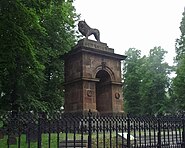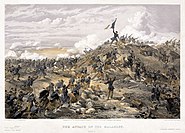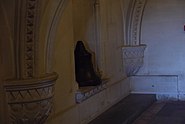| Siege of Sevastopol | |||||||
|---|---|---|---|---|---|---|---|
| Part of the Crimean War | |||||||
 Siege of Sevastopol by Franz Roubaud | |||||||
| |||||||
| Belligerents | |||||||
|
| ||||||
| Commanders and leaders | |||||||
|
| ||||||
| Strength | |||||||
| |||||||
| Casualties and losses | |||||||
| Total casualties: 102,000 killed, wounded, and died from disease[8] | ||||||
The Siege of Sevastopol lasted from September 1854 until September 1855, during the Crimean War. The allies (French, Ottoman, and British) landed at Eupatoria on 14 September 1854, intending to make a triumphal march to Sevastopol, the capital of the Crimea, with 50,000 men. The 35-mile (56 km) traverse took a year of fighting against the Russians. Major battles along the way were Alma (September 1854), Balaklava (October 1854), Inkerman (November 1854), Tchernaya (August 1855), Redan (September 1855), and, finally, Sevastopol (September 1855). During the siege, the allied navy undertook six bombardments of the capital, on 17 October 1854; and on 9 April, 6 June, 17 June, 17 August, and 5 September 1855.
Sevastopol is one of the classic sieges of all time.[9] The city of Sevastopol was the home of the Tsar's Black Sea Fleet, which threatened the Mediterranean. The Russian field army withdrew before the allies could encircle it. The siege was the culminating struggle for the strategic Russian port in 1854–1855 and was the final episode in the Crimean War.
During the Victorian Era, these battles were repeatedly memorialized. The Siege of Sevastopol was the subject of Crimean soldier Leo Tolstoy's Sebastopol Sketches and the subject of the first Russian feature film, Defence of Sevastopol. The Battle of Balaklava was made famous by Alfred, Lord Tennyson's poem "The Charge of the Light Brigade" and Robert Gibb's painting The Thin Red Line, as well as by a panorama of the siege painted by Franz Roubaud. Treating the wounded from these battles was celebrated English nurses Mary Seacole and Florence Nightingale.
Description[]
The allies (French, Ottoman, and British) landed at Eupatoria on 14 September 1854.[10] The Battle of the Alma (20 September 1854), which is usually considered the first battle of the Crimean War (1853–1856), took place just south of the River Alma in the Crimea.[11] An Anglo-French force under Jacques Leroy de Saint Arnaud and FitzRoy Somerset, 1st Baron Raglan defeated General Alexander Sergeyevich Menshikov's Russian army, which lost around 6,000 troops.[12]
Moving from their base at Balaklava at the start of October, French and British engineers began to direct the building of siege lines along the Chersonese uplands to the south of Sevastopol.[13] The troops prepared redoubts, gun batteries, and trenches.[14]
With the Russian army and its commander Prince Menshikov gone, the defence of Sevastopol was led by Vice Admirals Vladimir Alexeyevich Kornilov and Pavel Nakhimov, assisted by Menshikov's chief engineer, Lieutenant Colonel Eduard Totleben.[15] The military forces available to defend the city were 4,500 militia, 2,700 gunners, 4,400 marines, 18,500 naval seamen, and 5,000 workmen, totalling just over 35,000 men.
The Russians began by scuttling their ships to protect the harbour, then used their naval cannon as additional artillery and the ships' crews as marines.[16] Those ships deliberately sunk by the end of 1855 included Grand Duke Constantine, City of Paris (both with 120 guns), Brave, Empress Maria, Chesme, Yagondeid (84 guns), Kavarna (60 guns), Konlephy (54 guns), steam frigate Vladimir, steamboats Thunderer, Bessarabia, Danube, Odessa, Elbrose, and Krein.
By mid-October 1854, the Allies had some 120 guns ready to fire on Sevastopol; the Russians had about three times as many.[17]
On 17 October 1854 (old style date, 29 October new style)[lower-alpha 1] the artillery battle began.[18] The Russian artillery first destroyed a French magazine, silencing their guns. British fire then set off the magazine in the Malakoff redoubt, killing Admiral Kornilov, silencing most of the Russian guns there, and leaving a gap in the city's defences. However, the British and French withheld their planned infantry attack, and a possible opportunity for an early end to the siege was missed.
At the same time, the Allies' ships pounded the Russian defences, taking damage and inflicting little in return. The bombardment resumed the following day, but the Russians had worked through the night and repaired the damage. This pattern would be repeated throughout the siege.
During October and November 1854, the battles of Balaclava[19] and Inkerman[20] took place beyond the siege lines. Balaclava gave the Russians a morale boost and convinced them that the allied lines were thinly spread out and undermanned.[21] But after their defeat at Inkerman,[22] the Russians saw that the siege of Sevastopol would not be lifted by a battle in the field, so instead they moved troops into the city to aid the defenders. Toward the end of November, a winter storm ruined the Allies' camps and supply lines. Men and horses sickened and starved in the poor conditions.
While Totleben extended the fortifications around the Redan bastion and the Malakoff redoubt, British chief engineer John Fox Burgoyne sought to take the Malakoff, which he saw as the key to Sevastopol. Siege works were begun to bring the Allied troops nearer to the Malakoff; in response, Totleben dug rifle pits from which Russian troops could snipe at the besiegers. In a foretaste of the trench warfare that became the hallmark of the First World War, the trenches became the focus of Allied assaults.
The Allies were able to restore many supply routes when winter ended. The new Grand Crimean Central Railway, built by the contractors Thomas Brassey and Samuel Morton Peto, which had been completed at the end of March 1855[23] was now in use bringing supplies from Balaclava to the siege lines. The railroad delivered more than five hundred guns and plentiful ammunition.[23] The Allies resumed their bombardment on 8 April 1855 (Easter Sunday). On 28 June (10 July), Admiral Nakhimov died from a head wound inflicted by an Allied sniper.[24]
On 24 August (5 September) the Allies started their sixth and the most severe bombardment of the fortress. Three hundred and seven cannon fired 150,000 rounds, with the Russians suffering 2,000 to 3,000 casualties daily. On 27 August (8 September), thirteen Allied divisions and one Allied brigade (total strength 60,000) began the last assault. The British assault on the Great Redan failed, but the French, under General Patrice de Mac-Mahon, Duke of Magenta, managed to seize the Malakoff redoubt and the Little Redan, making the Russian defensive position untenable. By the morning of 28 August (9 September), the Russian forces had abandoned the southern side of Sevastopol.[8][25]
Although defended heroically and at the cost of heavy Allied casualties, the fall of Sevastopol would lead to the Russian defeat in the Crimean War.[1] Most of the Russian casualties were buried in Brotherhood cemetery in over 400 collective graves. The three main commanders (Nakhimov, Kornilov, and Istomin) were interred in the purpose-built Admirals' Burial Vault.
Battles during the siege[]
- Battle of Alma (September 1854)
- Battle of Balaclava (October 1854)
- Battle of Inkerman (November 1854)
- Battle of the Chernaya (August 1855)
- Battle of Malakoff (September 1855)
- Battle of the Great Redan (September 1855)
Fate of Sevastopol cannon[]

Three 17th Century Church Bells in Arundel Castle United Kingdom. These were taken from Sevastopol as trophies at the end of the Siege of Sevastopol
The British sent a pair of cannon seized at Sevastopol to each of several important cities in the Empire.[26][27] Additionally, several were sent to the Royal Military College Sandhurst and the Royal Military Academy Woolwich. These cannon now all reside at the Royal Military Academy Sandhurst (renamed after the closing of RMA Woolwich shortly after the Second World War) and are displayed in front of Old College next to cannon from Waterloo and other battles.
The cascabel (the large ball at the rear of old muzzle-loaded guns) of several cannon captured during the siege have been used to make the British Victoria Cross, the highest award for gallantry in the British Armed Forces. The metal from these cascabels will soon be exhausted, and there is some uncertainty as to what metal will be used once this occurs. There is some doubt as to the origin of the metal used in some of the medals awarded during the First World War.
Gallery[]
See also[]
- Sebastopol Sketches, a cycle of three historical fiction short stories written by Leo Tolstoy
- Defence of Sevastopol, Russia's first feature film
Notes[]
- ↑ In this article the first date given is the old style date, the date following is the modern equivalent. Conversions were completed using Calendar Converter by John Walker.
References[]
- ↑ 1.0 1.1 Bellamy, Christopher; Ed. Richard Holmes (2001). The Oxford Companion to Military History: Crimean War. Oxford University Press. ISBN 0-19-866209-2.
- ↑ 2.0 2.1 Советская Военная Энциклопедия, М., Воениздат 1979, т.7, стр.279
- ↑ Maule, Fox (1908). The Panmure Papers. London: Hodder and Stoughton, quoted in David Kelsey's Crimean Texts. http://crimeantexts.russianwar.co.uk/sources/panmure/pcont07.html.
- ↑ David G. Chandler, Atlas of Military Strategy, Lionel Levental Ltd 1980, ISBN 0-85368-134-1, p.146
- ↑ Blake, The Crimean War, Pen and Sword 1971, p.114
- ↑ or 38,000: David G. Chandler, Atlas of Military Strategy, Lionel Levental Ltd 1980, ISBN 0-85368-134-1, p.145
- ↑ John Sweetman, Crimean War, Essential Histories 2, Osprey Publishing, 2001, ISBN 1-84176-186-9, p.89
- ↑ 8.0 8.1 Советская Военная Энциклопедия, М., Воениздат 1979, т.7, стр.280
- ↑ Elphinstone, H.C (2003). Siege of Sebastopol 1854–55: Journal of the Operations Conducted by the Corps of Royal Engineers.
- ↑ Orlando Figes, The Crimean War: A History (Picador Publishing: New York, 2010) p. 230.
- ↑ Orlando Figes, The Crimean War: A History, pp. 208-220.
- ↑ Orlando Figes, The Crimean War: A History, p. 218.
- ↑ Orlando Figes, The Crimean War: A History, p. 236.
- ↑ Orlando Figes, The Crimean War: A History, p. 237.
- ↑ Orlando Figes, The Crimean War: A History, p. 233.
- ↑ Orlando Figes, The Crimean War: A History, p. 224.
- ↑ Orlando Figes, The Crimean War: A History, p. 238.
- ↑ Orlando, Figes, The Crimean War: A History, p. 238.
- ↑ Engels, Frederick. The War in the East. The Collected Works of Karl Marx and Frederick Engels. 13. pp. 521–527.
- ↑ Engels, Frederick. The Battle of Inkerman. The Collected Works of Karl Marx and Frederick Engels. 13. pp. 528–535.
- ↑ Orlaando Figes, The Crimean War: A History, p. 254.
- ↑ Frederick Engels, " The Battle of Inkerman" published on November 27, 1854 in the New York Herald and carried in the Colleccted Works of Karl Marx and Frederick Engels: Volume 13, pp. 528-535
- ↑ 23.0 23.1 Orlando Figes, The Crimean War: A History, p. 356.
- ↑ Orlando Figes, The Crimean War: A History, p. 378.
- ↑ Troubetzkoy, Alexis (2006). The Crimean War: The Causes and Consequences of a Medieval Conflict Fought in a Modern Age. London: Constable & Robinson. p. 288.
- ↑ "Two 1799 Russian 24 Pdrs. Watch The St. Lawrence River In Quebec"
- ↑ "The Russian SBML 18-pr at Waiouru", Royal New Zealand Artillery Association
- ↑ Grant, Simon (2005). A Terrible Beauty from Tate etc magazine, issue 5, accessed 2007-09-27
External links[]
- Letters and Papers of Colonel Hugh Robert Hibbert (1828–1895) Mainly relating to service in the Crimean War, 1854–1855.
- Historical Dictionary of the Crimean War
- Henry Ottley. Remarkable Sieges: From The Siege Of Constantinople In 1453, To That Of Sebastopol, 1854 (1854). 2010.
The original article can be found at Siege of Sevastopol (1854–1855) and the edit history here.


![Roger Fenton - Shadow of the Valley of Death.jpg (9.74 MB) A view of the "Valley of the Shadow of Death" near Sevastopol, taken by Roger Fenton in March 1855. It was so named by soldiers because of the number of cannonballs that landed there, falling short of their target, during the siege.[28]](https://upload.wikimedia.org/wikipedia/commons/thumb/6/65/Roger_Fenton_-_Shadow_of_the_Valley_of_Death.jpg/185px-Roger_Fenton_-_Shadow_of_the_Valley_of_Death.jpg)







